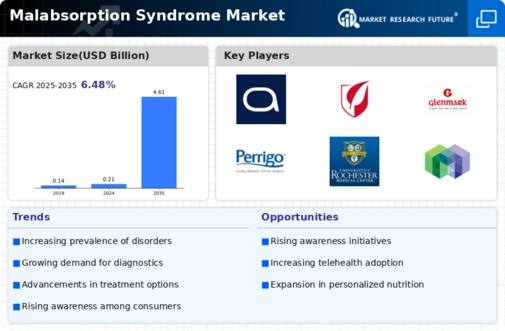Market Share
Malabsorption Syndrome Market Share Analysis
The market dynamics of Malabsorption Syndrome reflect a multifaceted landscape shaped by various factors that influence the diagnosis, treatment, and management of this gastrointestinal disorder. Malabsorption Syndrome is characterized by the inadequate absorption of nutrients in the small intestine, leading to a range of nutritional deficiencies and digestive challenges. One key driver of market dynamics is the increasing prevalence of gastrointestinal disorders and related conditions, raising awareness among healthcare professionals and patients alike. As the incidence of conditions such as celiac disease, Crohn's disease, and pancreatic insufficiency rises, the demand for effective diagnostic tools and therapeutic interventions for Malabsorption Syndrome follows suit.
Technological advancements in diagnostic modalities contribute significantly to the market dynamics of Malabsorption Syndrome. Innovations in imaging techniques, such as magnetic resonance enterography (MRE) and capsule endoscopy, enhance the accuracy and efficiency of diagnosing malabsorption-related disorders. These technological developments empower healthcare providers to identify the root causes of malabsorption, facilitating timely and targeted treatment strategies. The continuous evolution of diagnostic tools also underscores the commitment of the healthcare industry to improve patient outcomes and enhance the overall quality of care for individuals with Malabsorption Syndrome.
The pharmaceutical sector plays a crucial role in shaping the market dynamics of Malabsorption Syndrome, with a focus on developing therapeutic interventions to manage and alleviate symptoms. The advent of novel drugs and treatment options, including enzyme replacement therapies and innovative medications, addresses the specific challenges associated with malabsorption-related conditions. The pharmaceutical industry's response to the diverse needs of patients with Malabsorption Syndrome contributes to the overall growth and competitiveness of the market.
Another significant aspect of the market dynamics is the emphasis on personalized medicine and tailored treatment approaches. Recognizing the heterogeneity of Malabsorption Syndrome and its underlying causes, healthcare providers increasingly adopt personalized treatment plans that consider individual patient characteristics and responses. This trend fosters the development of targeted therapies, leading to better patient outcomes and improved quality of life for those affected by Malabsorption Syndrome.
Collaboration and partnerships between healthcare organizations, research institutions, and pharmaceutical companies are instrumental in advancing the understanding and management of Malabsorption Syndrome. These collaborative efforts promote knowledge exchange, facilitate clinical trials, and drive research initiatives aimed at developing innovative solutions. The synergy between different stakeholders in the healthcare ecosystem contributes to a more comprehensive and holistic approach to addressing the complexities of Malabsorption Syndrome.
Market dynamics are also influenced by the regulatory landscape governing the diagnosis and treatment of Malabsorption Syndrome. Adherence to stringent regulations ensures the safety and efficacy of diagnostic tests and therapeutic interventions. Regulatory frameworks guide the development and approval of new drugs, diagnostic devices, and treatment protocols, providing a framework for healthcare providers to navigate in their efforts to address Malabsorption Syndrome.
Economic factors, including healthcare spending and reimbursement policies, significantly impact the market dynamics of Malabsorption Syndrome. The economic feasibility of diagnostic tests, medications, and treatment options influences their accessibility and adoption within healthcare systems. As stakeholders seek cost-effective solutions that align with budgetary constraints, the market responds with a focus on delivering value-based care for individuals affected by Malabsorption Syndrome.











Leave a Comment